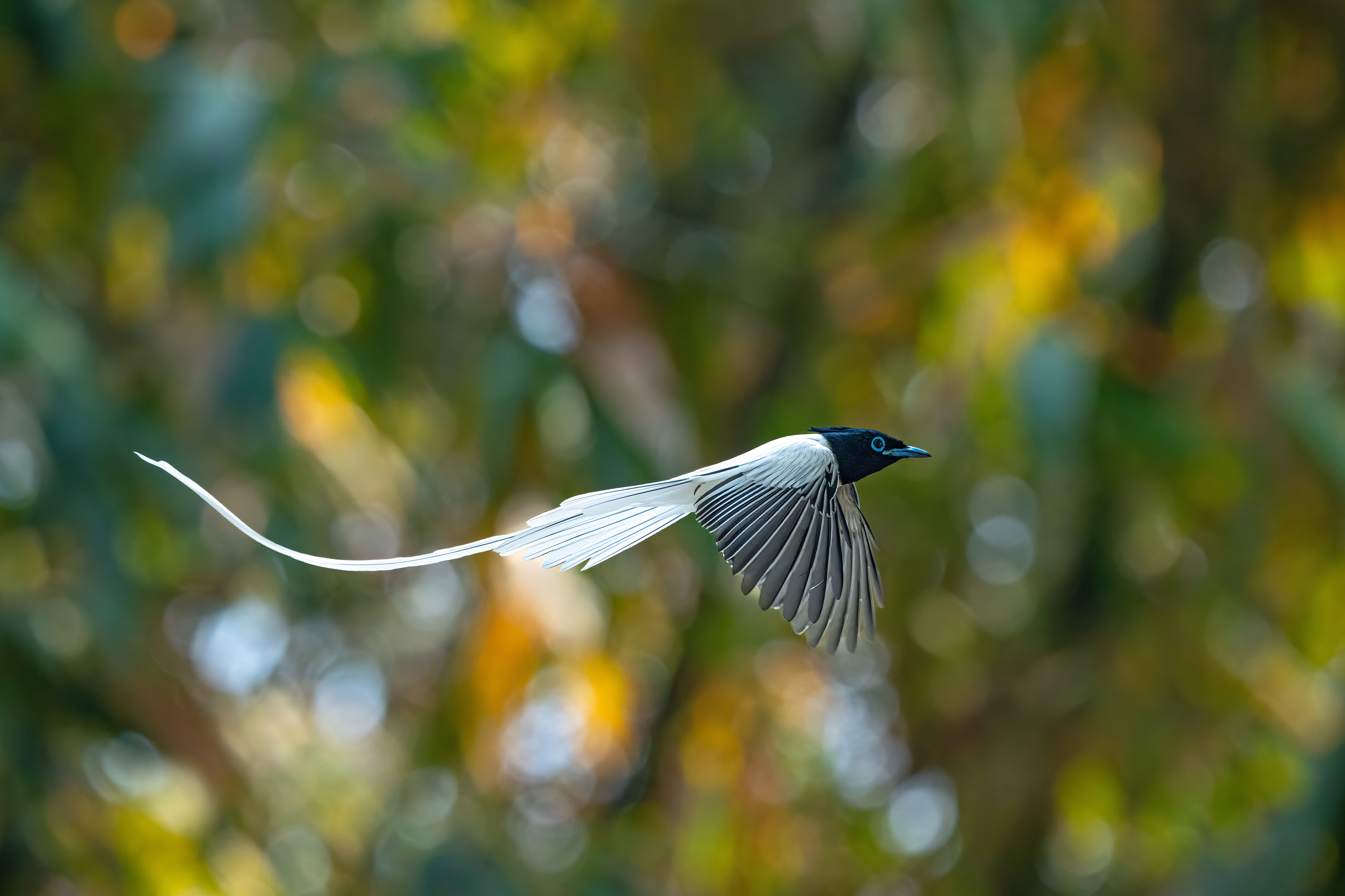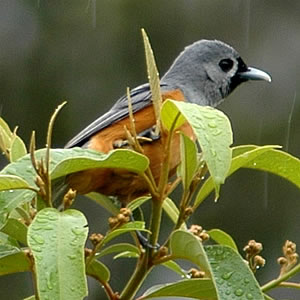|
Indian Paradise Flycatcher
The Indian paradise flycatcher (''Terpsiphone paradisi'') is a medium-sized passerine bird native to Asia, where it is widely distributed. As the global population is considered stable, it has been listed as Least Concern on the IUCN Red List since 2004. It is native to the Indian subcontinent, Central Asia and Myanmar. Males have elongated central tail feathers, and a black and rufous plumage in some populations, while others have white plumage. Females are short-tailed with rufous wings and a black head. Indian paradise flycatchers feed on insects, which they capture in the air often below a densely canopied tree. Taxonomy The Indian paradise flycatcher was Species description, formally described in 1758 by the Swedish naturalist Carl Linnaeus in the 10th edition of Systema Naturae, tenth edition of his ''Systema Naturae'' under the binomial nomenclature, binomial name ''Corvus paradisi''. The Indian paradise flycatcher is now one of 17 paradise flycatchers placed in the genus ... [...More Info...] [...Related Items...] OR: [Wikipedia] [Google] [Baidu] |
Carl Linnaeus
Carl Linnaeus (23 May 1707 – 10 January 1778), also known after ennoblement in 1761 as Carl von Linné,#Blunt, Blunt (2004), p. 171. was a Swedish biologist and physician who formalised binomial nomenclature, the modern system of naming organisms. He is known as the "father of modern Taxonomy (biology), taxonomy". Many of his writings were in Latin; his name is rendered in Latin as and, after his 1761 ennoblement, as . Linnaeus was the son of a curate and was born in Råshult, in the countryside of Småland, southern Sweden. He received most of his higher education at Uppsala University and began giving lectures in botany there in 1730. He lived abroad between 1735 and 1738, where he studied and also published the first edition of his ' in the Netherlands. He then returned to Sweden where he became professor of medicine and botany at Uppsala. In the 1740s, he was sent on several journeys through Sweden to find and classify plants and animals. In the 1750s and 1760s, he co ... [...More Info...] [...Related Items...] OR: [Wikipedia] [Google] [Baidu] |
Monarch Flycatcher
The monarchs or monarch flycatchers (family Monarchidae) comprise a family of over 100 passerine birds which includes shrikebills, paradise flycatchers, and Grallina, magpie-larks. Monarchids are small insectivore, insectivorous songbirds with long tails. They inhabit forest or woodland across sub-Saharan Africa, south-east Asia, Australasia, and a number of Pacific islands. Only a few species migrate. Many species decorate their cup-shaped nests with lichen. Taxonomy Some of the one hundred or more species making up the family were previously assigned to other groups, largely on the basis of general morphology or behaviour. The magpie-lark, for example, was assigned to the same family as the white-winged chough, since both build unusual nests from mud rather than vegetable matter. That family, Grallinidae, is now considered a Synonym (taxonomy), synonym of Monarchidae. It was formerly considered to have four species. The magpie-lark and the torrent-lark were moved into Monarc ... [...More Info...] [...Related Items...] OR: [Wikipedia] [Google] [Baidu] |
British Museum Of Natural History
The Natural History Museum in London is a museum that exhibits a vast range of specimens from various segments of natural history. It is one of three major museums on Exhibition Road in South Kensington, the others being the Science Museum (London), Science Museum and the Victoria and Albert Museum. The Natural History Museum's main frontage, however, is on Cromwell Road. The museum is home to life and earth science specimens comprising some 80 million items within five main collections: botany, entomology, mineralogy, palaeontology and zoology. The museum is a centre of research specialising in Taxonomy (biology), taxonomy, identification and conservation. Given the age of the institution, many of the collections have great historical as well as scientific value, such as specimens collected by Charles Darwin. The museum is particularly famous for its exhibition of dinosaur skeletons and ornate architecture—sometimes dubbed a ''cathedral of nature''—both exemplified by the ... [...More Info...] [...Related Items...] OR: [Wikipedia] [Google] [Baidu] |
Indian Paradise Flycatcher - Female - TATR
Indian or Indians may refer to: Associated with India * of or related to India ** Indian people ** Indian diaspora ** Languages of India ** Indian English, a dialect of the English language ** Indian cuisine Associated with indigenous peoples of the Americas * Indigenous peoples of the Americas ** First Nations in Canada ** Native Americans in the United States ** Indigenous peoples of the Caribbean ** Indigenous languages of the Americas Places * Indian, West Virginia, U.S. * The Indians, an archipelago of islets in the British Virgin Islands Arts and entertainment Film * ''Indian'' (film series), a Tamil-language film series ** ''Indian'' (1996 film) * ''Indian'' (2001 film), a Hindi-language film Music * Indians (musician), Danish singer Søren Løkke Juul * "The Indian", an unreleased song by Basshunter * "Indian" (song), by Sturm und Drang, 2007 * "Indians" (song), by Anthrax, 1987 * Indians, a song by Gojira from the 2003 album '' The Link'' Other uses i ... [...More Info...] [...Related Items...] OR: [Wikipedia] [Google] [Baidu] |
Hermann Harms
Hermann August Theodor Harms (16 July 1870 – 27 November 1942) was a German taxonomist and botanist. Harms was born in Berlin. He worked as a botanist at the Berlin-Dahlem Botanical Garden and Botanical Museum, Botanical Museum in Berlin. He was a member of the Prussian Academy of Sciences. He died in Berlin, aged 72. He was longtime editor of Adolf Engler's "''Das Pflanzenreich''", and was the author of several chapters on various plant families in Engler and Carl Prantl, Prantl's "''Die Natürlichen Pflanzenfamilien''", including the chapters on Bromeliaceae (1930) and Nepenthaceae (1936). In the latter he revised the pitcher plant genus ''Nepenthes'', dividing it into three subgenera: ''Anurosperma'', ''Eunepenthes'' and ''Mesonepenthes'' (see Taxonomy of Nepenthes, Taxonomy of ''Nepenthes''). Furthermore, he was interested in the genus ''Passiflora''. The plant genera ''Harmsia'' (Schum.), ''Harmsiella'' (John Isaac Briquet, Briq.), ''Harmsiodoxa'' (in the Brassicacea ... [...More Info...] [...Related Items...] OR: [Wikipedia] [Google] [Baidu] |
Nikolai Zarudny
Nikolai Alekseyvich Zarudny (;. His name has been transliterated a number of other ways; especially with ''Sarudny'' or ''Sarudney'' in older works. 13 September 1859 – 17 March 1919) was a Ukrainian- Russian explorer and zoologist who studied the flora and fauna of Central Asia. He was born in Gryakovo, Kharkov Governorate, Russian Empire (now in Poltava Oblast of Ukraine). He wrote his first ornithology book in 1896 and made five expeditions in the Caspian region between 1884 and 1892. He led other expeditions to Persia supported by the Russian Geographical Society and the Zoological Museum of the Zoological Institute of the Russian Academy of Sciences. He collected nearly 3,140 specimens of birds and 50,000 insects. After the Russian Revolution, his collection was nationalized by the Bolsheviks and moved to the museum at the University of Tashkent. For his work, the Russian Geographical Society awarded him the Przhevalsky Medal. His last work on the ornithology of Tur ... [...More Info...] [...Related Items...] OR: [Wikipedia] [Google] [Baidu] |
Himalayas
The Himalayas, or Himalaya ( ), is a mountain range in Asia, separating the plains of the Indian subcontinent from the Tibetan Plateau. The range has some of the Earth's highest peaks, including the highest, Mount Everest. More than list of highest mountains on Earth, 100 peaks exceeding elevations of above sea level lie in the Himalayas. The Himalayas abut on or cross territories of Himalayan states, six countries: Nepal, China, Pakistan, Bhutan, India and Afghanistan. The sovereignty of the range in the Kashmir region is disputed among India, Pakistan, and China. The Himalayan range is bordered on the northwest by the Karakoram and Hindu Kush ranges, on the north by the Tibetan Plateau, and on the south by the Indo-Gangetic Plain. Some of the world's major rivers, the Indus River, Indus, the Ganges river, Ganges, and the Yarlung Tsangpo River, Tsangpo–Brahmaputra River, Brahmaputra, rise in the vicinity of the Himalayas, and their combined drainage basin is home to some 6 ... [...More Info...] [...Related Items...] OR: [Wikipedia] [Google] [Baidu] |
Tian Shan
The Tian Shan, also known as the Tengri Tagh or Tengir-Too, meaning the "Mountains of God/Heaven", is a large system of mountain ranges in Central Asia. The highest peak is Jengish Chokusu at high and located in Kyrgyzstan. Its lowest point is at the Turpan Depression, which is below sea level. The Tian Shan is sacred in Tengrism. Its second-highest peak is known as Khan Tengri, which can be translated as "Lord of the Spirits". At the 2013 Conference on World Heritage, the eastern portion of Tian Shan in western China's Xinjiang Region was listed as a World Heritage Site. The western portion in Kyrgyzstan, Kazakhstan, and Uzbekistan was then listed in 2016. Geography Tian Shan with the ancient Silk Road The Tian Shan range is located north and west of the Taklamakan Desert and directly north of the Tarim Basin. It straddles the border regions of Kazakhstan, Kyrgyzstan, Uzbekistan and Xinjiang in Northwest China. To the south, it connects with the Pamir Mountains ... [...More Info...] [...Related Items...] OR: [Wikipedia] [Google] [Baidu] |
William Swainson
William Swainson Fellow of the Linnean Society, FLS, Fellow of the Royal Society, FRS (8 October 1789 – 6 December 1855), was an English ornithologist, Malacology, malacologist, Conchology, conchologist, entomologist and artist. Life Swainson was born in Dover Place, St Mary Newington, London, the eldest son of John Timothy Swainson, an original fellow of the Linnean Society of London, Linnean Society. He was a cousin of the amateur botanist Isaac Swainson.Etymologisches Worterbuch der botanischen Pflanzennamen by H. Genaust. Review by Paul A. Fryxell ''Taxon'', Vol. 38(2), 245–246 (1989). His father's family originated in Lancashire, and both his grandfather and father held high posts in Her Majesty's Customs, his father becoming Collector at Liverpool. William, whose formal education was curtailed because of an speech impediment, impediment in his speech, joined the Liverpool Customs as a junior clerk at the age of 14."William Swainson F.R.S, F.L.S., Naturalist and Arti ... [...More Info...] [...Related Items...] OR: [Wikipedia] [Google] [Baidu] |
Subspecies
In Taxonomy (biology), biological classification, subspecies (: subspecies) is a rank below species, used for populations that live in different areas and vary in size, shape, or other physical characteristics (Morphology (biology), morphology), but that can successfully interbreed. Not all species have subspecies, but for those that do there must be at least two. Subspecies is abbreviated as subsp. or ssp. and the singular and plural forms are the same ("the subspecies is" or "the subspecies are"). In zoology, under the International Code of Zoological Nomenclature, the subspecies is the only taxonomic rank below that of species that can receive a name. In botany and mycology, under the International Code of Nomenclature for algae, fungi, and plants, other infraspecific name, infraspecific ranks, such as variety (botany), variety, may be named. In bacteriology and virology, under standard International Code of Nomenclature of Prokaryotes, bacterial nomenclature and virus clas ... [...More Info...] [...Related Items...] OR: [Wikipedia] [Google] [Baidu] |
Asian Paradise Flycatcher
In 2015, the Asian paradise flycatcher was split into the following three species: * Indian paradise flycatcher The Indian paradise flycatcher (''Terpsiphone paradisi'') is a medium-sized passerine bird native to Asia, where it is widely distributed. As the global population is considered stable, it has been listed as Least Concern on the IUCN Red List sin ... (''Terpsiphone paradisi'') * Blyth's paradise flycatcher (''Terpsiphone affinis'') * Amur paradise flycatcher (''Terpsiphone incei'') References {{Reflist Birds by common name ... [...More Info...] [...Related Items...] OR: [Wikipedia] [Google] [Baidu] |





